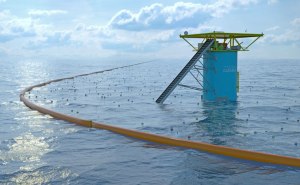There’s a nice piece in the BBC news this week about the ‘Tjipetir mystery’: tablets of a strange rubbery material washing up on beaches all around Europe, each with ‘TJIPETIR’ embossed on one side.
It isn’t a viral marketing campaign for some new Dot Com (incidentally, don’t bother: tjipetir.com is already registered) nor a message from the occupants of flying saucers. In fact, Tjipetir is the name of an Indonesian rubber plantation, and these were slabs of raw material. They are believed to be gutta-percha, a latex material collected as sap from a family of trees, later edged out by the emergence of plastics such as Bakelite.
The suspected source of the strange tablets is the wreck of a Japanese liner, the Miyazaki Maru, sunk by a German U-boat in 1917. A recent salvage operation appears to have dislodged a number of the tablets, allowing them to float free and find their way onto beaches a thousand miles apart.
Twenty-five years, it is said, is all it takes for a piece of flotsam to circle the globe. This power of the tide was once harnessed to keep a remote Scottish community connected with the rest of Britain: the people of St Kilda would construct “mail boats” from just about anything that would float, plus a watertight tin or bottle, containing letters. This would be flung into the sea, and left to take its chances. Included was some money, to pay the postage when the letter was recovered and put into the mail system. In a more honest age, about two thirds of the letters sent this way found their mark.
Then there’s Perranporth in Cornwall: the beach where Lego bricks keep washing up. Seventeen years ago, a freak wave caused the container ship Tokio Express to lose 62 shipping containers from its deck, while about 20 miles off Land’s End. One of the containers held 4,756,940 Lego pieces, and many of them have floated free. Although they’ve been a little bit abraded by the action of sand and wave, children (and others) love collecting them.
Plastics are incredibly useful: can you imagine modern life without them? I can’t… but when they end up in the sea, their durability and low density are no longer an asset, but a curse. Stepping up to deal with that curse is Boyan Slat. He might look as if he ought to be smuggling a priceless ring into Mordor in a Peter Jackson movie, but the Dutch youngster’s quest is probably harder: he wants to rid the world’s oceans of plastic waste. A lot of young people have expressed a desire to tackle environmental problems, and made this the subject of a school project… but how many went on to raise $2 million to fund a programme of experiments? At 18 years old, he was a pretty persuasive speaker, too.
Boyan Slat’s proposed approach features a floating boom, mid-ocean, tethered to the seabed. The vortices of water responsible for concentrating the floating garbage into mid-ocean patches – gyres – will deliver plastic waste into his boom system without any need to sail up and down, collecting it. Just as the current was employed on St Kilda to send the mail on its way, it obligingly delivers the waste with no energy required.
Not everybody thinks this is the best solution. For example, some say that the price of the mid-ocean garbage collector could better be spent on preventing plastics ending up in the ocean in the first place. (It’s estimated that a tenth of the 288 million tonnes of plastic products made every year end up in the sea.) Others point out that although there’s a lot of plastic waste, much of it is microscopic, and not all of it is at the surface, as plastic waste is found throughout the water column, and on the seabed.
The approach remains controversial, but do you know what I’ve learned? The smallest good deed is better than the greatest good intention. It might not be perfect, but it’s happening. How many other teenagers could you name who secured the involvement of seventy engineers and scientists, to produce a 530-page proposal for an environmental project? Experiments continue, and the first platform for the North Atlantic gyre should be ready by 2020.
In a climate of environmental doom and gloom, where people despair about “the world we’re leaving to future generations”, the first of those generations has come out fighting.






Pingback: #Plasticbagchaos, or The End of the World as We Know it | Capacify
Pingback: Faster than a Speeding Bullet | Capacify